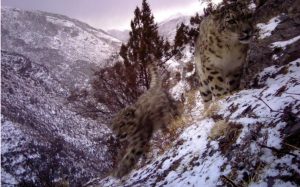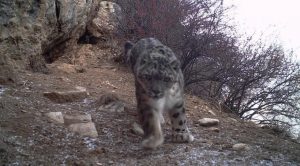
Photo: xinhuanet.com
Snow leopards have been captured on film in the south east of the Tibet Autonomous Region – the first time images have been obtained in this area. Chinese state media Xinhua news agency reported on December 18 that the images of the leopards were taken in the Nujiang River Valley in eastern Tibet, the Nujiang is a largely free flowing river unobstructed by dams or other projects.
The snow leopards were captured “several times” on infrared cameras set up by the Chinese Shan Shui Conservation Centre. “We have captured images of baby leopards with their motherwhich indicates that a certain quantity of the rare species live in the region,” said Zhao Xiang, head of the Conservation Centre, speaking to Xinhua.
The Xinhua report continued, “Local official said their appearance in the populous region in eastern Tibet showed efforts to protect the local ecosystem and biological diversity were successful”.

Photo: xinhuanet.com
Snow leopards are a Class A protected animal in China and are classified as “endangered”. They are solitary and elusive in nature but have been captured on film in other regions of the Himalayas. Non-invasive infrared cameras are used which automatically record footage when they detect a warm-blooded creature passing by.

Nujiang River Valley in eastern Tibet
File Photo: dreamstime.com
The World Wildlife Foundation estimates that there are between 4,080 and 6,590 snow leopards in the wild, living in a vast habitat spanning northern and central Asia. Their population is suspected to have declined by 20% over the past 16 years, due to habitat loss from climate change, reduced prey, poaching and retaliatory killings by local farmers.




 Print
Print Email
Email